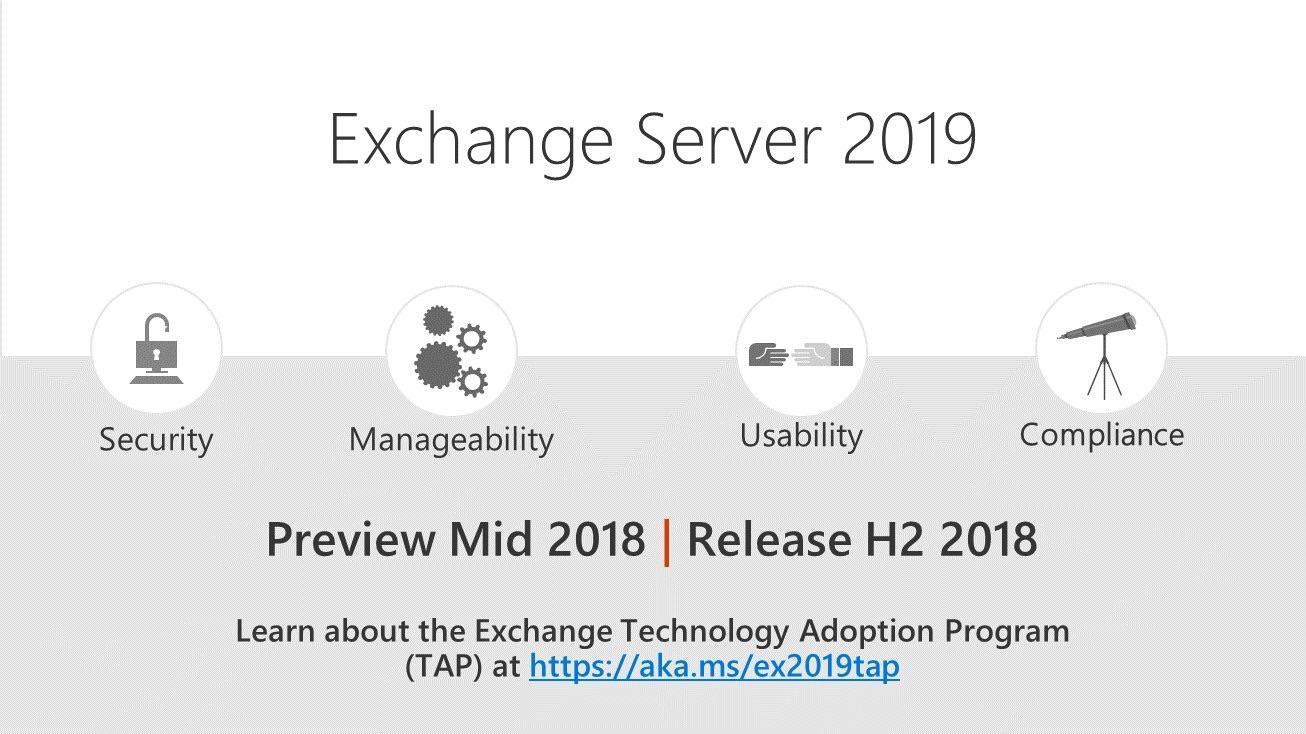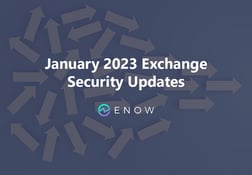November 2022 Security Updates for Exchange
This week Microsoft released new security updates for the following Exchange versions:
- Exchange...


At a recent Exchange MVP panel discussion at Ignite 2017, a question came up that I’ve been asked at previous panels. The spirit of these questions were around the future of Exchange Server On-Premises in relation to Office 365. Will there be another on-premises Exchange Server version? If so, how will its features stack up against Exchange Online? What role will Exchange Administrators play in the coming years? I wanted to share my thoughts and experiences on this topic, as it appears to be one keeping many Exchange Server Administrators and Consultants up at night.
At Ignite 2017, Microsoft quickly answered the question of whether Exchange Server would exist solely in the clouds by announcing Exchange Server 2019 on-premises; expected to be released in late 2018. As Exchange experts and Microsoft insiders agree, a desire to keep mailboxes on-premises still exists for a sizable portion of the market (some feel 40% of mailboxes will remain on-premises for the foreseeable future), therefore this announcement shouldn’t have come as a surprise. What Exchange Server 2019 will actually look like is where we’ll see the really interesting questions. Will the licensing model change? Will the changes be more end-user feature focused or more “under the hood” enhancements? How will Exchange 2019 compare to Exchange Online? Those wishing to join the Exchange Server TAP (Technology Adoption Program) will get those answers sooner than the general public, but let’s lay out what we know now:
(Data obtained via Microsoft Lifecycle Policy)
These are the dates at which even Microsoft Premier Support will disallow support cases for the products in question to be opened for any reason. In some situations, Microsoft will offer a specialized support contract extension (as seen with Windows XP) that is actually priced so high that they hope it does not sell (Microsoft doesn’t publicly say this of course). However, such contracts are rarely even offered.
The Exchange Product team has also typically abided by an N-2 policy of supported Exchange Server and Outlook client versions. For Example, Exchange 2010 supported coexistence with the two previous Exchange Server versions and connectivity from their respective Outlook clients (Exchange/Outlook 2003 and 2007). Exchange 2013 similarly supported Exchange/Outlook 2007 and 2010, while Exchange 2016 supports Exchange/Outlook 2010 and 2013. If you attempt to install Exchange 2016 into a Forest which still has Exchange 2007 server objects within it, the installer will warn you of the non-compliance and prevent completion until the object is removed. The question will become whether this will be a similar story with Exchange 2019 and Exchange 2010 (it now being 3 versions behind and beyond the N-2 guidelines). I imagine if this is the case, impactful decisions will need to be made about whether an Exchange 2010 environment (soon to be unsupported in 2020) should look towards Exchange 2016, or perhaps a dual hop migration from 2010 to 2016, and then 2019. It’s possible that third-party migration solutions will make these decisions easier.
Looking forward, based on the typical 10 year product lifecycle Microsoft follows, it’s a safe bet to say when Exchange Server 2019 reaches General Availability (presumably in late 2018), it too will have a 10 year support lifecycle. This would mean Microsoft is making a commitment to Exchange on-premises at least until late 2028. For the sake of discussion, this is assuming there is no future release of Exchange Server on-premises (Exchange Server 2021? Exchange Server Perennial Edition? Or Simply Exchange Server On-Premises?). This is where I’d like to turn the discussion towards history, and reflect upon the last 7 years of Exchange Server. This October, Microsoft celebrated the 7 year anniversary of the announcement of Office 365. While BPOS and Microsoft Online Services existed before this date, this was the big step that marked the beginning of Office 365 as we know it today. However, it was not seen as the game changer it has come to be known as today. With no easy means of moving Exchange data into “The Service” (as it is commonly referred to within Microsoft) or a way for companies to “test the waters” of the offering, there wasn’t much movement in the Exchange space early on.
I remember it was January of 2012 when I first attended a training for Exchange Hybrid. I was attending Microsoft Certified Master training in Redmond, WA and the final 3 days were dedicated to Office 365; specifically, Exchange Hybrid. I wish I could share the original lab guides for the class but they would likely trigger a panic attack for anyone who had to configure Exchange Hybrid in these early days. I feel only the people who’ve had to configure Exchange Hybrid manually can truly appreciate the value of the Hybrid Configuration Wizard we often take for granted today. Secure mail flow, Organization Relationships, Delivery Domains, Namespaces/URLs, OWA redirection, MailTips, Message Tracking, Federation, etc. Each had to be configured manually using steps which were very prone to human error. All using management tools which were never designed to be integrated with the cloud. Then configuring ADFS and publishing it all through TMG; which had its own set of headaches. At the time, the Hybrid Configuration Wizard had just been released, but had a flurry of early challenges. Fortunately, over time it evolved into somewhat of an afterthought due to it now being so efficient and easy to use.
I bring this up because I wanted to paint a picture of how far the world of Exchange has come over these short years. As mentioned, Exchange Hybrid really wasn’t usable to the masses until the beginning of 2012. Assuming we agree that Exchange mailboxes are one of, if not the single biggest driver of Office 365 adoption, we can see that in a span of 6-7 years Exchange Online has gone from something IT departments laughed at to something they find themselves unable to avoid.
I believe these are important things to consider when asking yourself what the future holds for an Exchange Administrator or trying to make predictions further than a few years into the future. I’ve often said you should take with a grain of salt anyone’s opinion who claims to predict anything in the IT industry more than 5 years out, as so much can change so quickly. So when I get asked by a newcomer to IT whether they should bother learning Exchange, or a seasoned Exchange veteran if they should learn a new skill, or if there’s value in Exchange on-premises, I typically give a short “yes”. Followed by the suggestion to always be learning new skills in the IT world, both technical and non-technical. Seven years ago, few thought an Exchange Professional needed to understand ADFS, Office 365 licensing, directory synchronization, networking in a hybrid cloud environment, or the many other desired skillsets of a modern messaging Professional. Similarly, ~15 years ago in the days of Exchange 2003, fewer Exchange Professionals were expected to understand PKI, scripting/shell (this was before the days of PowerShell), virtualization, or load balancing, but those are now considered skills a seasoned messaging professional should possess. Therefore, the need to continue learning new skillsets is not a new one, this is simply the next generation of in-demand skills that a professional would be doing a disservice to themselves to ignore. The moment you get complacent in IT is the moment you get left behind.
So what about the discrepancy between Exchange Online and on-premises? Well if we were to remove the many added features and benefits offered in Office 365 that aren’t solely Exchange-related (Groups/Teams/Graph/etc.), the biggest value-add is mailbox size and the operational savings of no longer requiring backups. Each of these can be addressed by deploying the Preferred Architecture on-premises. I actually heard an Exchange Server Product Team member at Ignite say, “Deploying on-premises doesn’t make much sense unless you’re offering mailbox size parity. We give you a 50 GB mailbox in Office 365, so you should be trying to match that on-premises.” I very much agree with this statement, as I’m a firm believer that you pay your employees to be productive, and wasting time cleaning out their mailbox every month is not a productive activity. Though from a feature enhancement perspective, what can Exchange 2019 give on-premises customers and will Microsoft be incentivized to bring enhancements on-premises? I believe they will from a simple cost perspective, as it costs Microsoft more money to support older products. Microsoft is always incentivized to persuade customers into moving to newer product versions, as that gives them fewer scenarios to perform Quality Assurance testing and validation against. If Microsoft could wave a magic wand and get every on-premises customer to migrate to Exchange 2016 (with the latest Cumulative Update), they would be overjoyed. It is for these reasons that I believe Microsoft will do everything they can to make Exchange Server 2019 desirable to customers. However, we need to be realistic in knowing there are certain Office 365 features that are unlikely to ever see on-premises due to the complex nature of the many different products and technologies coming together in one of the most operationally mature environments in the world (Office 365/Azure). I believe if Site Mailboxes taught us anything, it’s that simply getting Exchange and SharePoint to interoperate successfully was a challenge for many organizations. Therefore, it would be a support nightmare for Microsoft to offer their Office 365 services on-premises (an Azure Stack-like solution for Office 365 perhaps?). The announcement of Modern Authentication for Exchange On-Premises at Ignite already has many Exchange Consultants wondering how many hours to bill for getting Exchange, Azure AD, and ADFS to properly integrate; just to match a feature that can be configured in a matter of minutes in Office 365. So I feel the short answer here is to expect worthwhile changes in Exchange 2019, but expecting full feature parity with Office 365 is unrealistic.
It’s certainly been an exciting 7 years, but knowing we’ll have a supported on-premises Exchange Server version for at least the next 11 years will hopefully ease some fears. At the very least, it will cause some to reflect upon how much has changed in the last 7 years of Exchange Server and realize much more can change in the coming years. Maybe something happens between now and then which tarnishes the clouds reputation and there’s a massive return to on-premises? Exchange has come a long way (it turned 21 years old this year, so it can legally drink here in the US) and evolved from very humble beginnings into a key component in Microsoft’s highly successful cloud business. I expect it to continue maturing with time, maybe not the huge leaps like we’ve seen between Exchange 2010 and 2013, but more subtle refined enhancements. With that, I’d like to leave you with a quote from John Gall, “A complex system that works is invariably found to have evolved from a simple system that worked. A complex system designed from scratch never works and cannot be patched up to make it work. You have to start over with a working simple system.”
Interested in getting visibility into your current on-prem environment? With Mailscape, you'll see the entire landscape of your Microsoft Exchange environment, eliminate costly outages, and provide crucial analytics for key stakeholders:

I work for Dell as a Principal Engineer in the Global Support & Deployment organization; serving as a senior point of escalation for Microsoft technologies to Dell's ProSupport & Consulting Services customers. My specialties are Exchange, Office 365, & Directory Services; while also being responsible for internal training development/delivery & managing various projects. I'm a Microsoft Certified Master in Exchange 2010 & a Microsoft Certified Solutions Master in Exchange 2013. I enjoy getting to work with a wide variety of customers, as it allows me to assist in resolving the various complexities & challenges they encounter. I try to use that experience to help others by blogging at Exchangemaster.wordpress.com with a few of my fellow MCM's at Dell. I also co-founded an Exchange Server community on Reddit (Reddit.com/r/ExchangeServer) where I answer questions on the product & help lead discussion around Exchange/Office 365. You'll also find me blogging about various other topics at ashdrewness.wordpress.com. I'm also the co-author of the Exchange Server Troubleshooting Companion (http://exchangeserverpro.com/ebooks/exchange-server-troubleshooting-companion/) I enjoy spending time with my lovely wife Lindsay, am a Texas Longhorns/Houston Texans fan, & try to sneak out onto a golf course every chance I get.


This week Microsoft released new security updates for the following Exchange versions:


On January 10, 2023, Microsoft released new Security Updates for Exchange 2013 CU23, Exchange 2016...